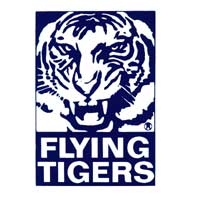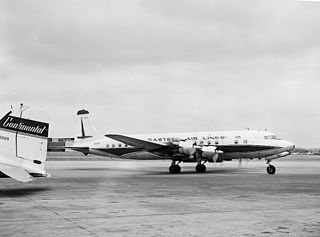
Canadian Pacific Air Lines was a Canadian airline that operated from 1942 to 1987. It operated under the name CP Air from 1968 to 1986. Headquartered at Vancouver International Airport in Richmond, British Columbia, it served domestic Canadian as well as international routes until it was purchased by Pacific Western Airlines and absorbed into Canadian Airlines International.
This is a list of aviation-related events from 1976.
This is a list of aviation-related events from 1997.

Flying Tiger Line, also known as Flying Tigers, was the first scheduled cargo airline in the United States and a major military charter operator during the Cold War era for both cargo and personnel. The airline was bought by Federal Express in 1988.

Austin Airways was a passenger airline and freight carrier based in Timmins, Ontario, and one of the oldest in Canada.

Eastern Air Lines Flight 512 was a scheduled domestic passenger flight operated by Eastern Air Lines from Charlotte Municipal Airport in Charlotte, North Carolina, to Idlewild Airport in New York City. On November 30, 1962, while attempting to abort an attempted landing at its destination, the Douglas DC-7B operating the flight crashed after it failed to gain altitude and struck the ground. 25 of the 51 occupants of the plane died in the accident. Emergency crews responded, but rescuers were delayed by the thick fog and the soft terrain. An investigation launched after the crash found that the probable cause of the accident was that the pilots had made critical mistakes during the go-around that prevented the aircraft from gaining altitude.

The McDonnell Douglas DC-9 is an American five-abreast, single-aisle aircraft designed by the Douglas Aircraft Company. It was initially produced as the Douglas DC-9 prior to August 1967, after which point the company had merged with McDonnell Aircraft to become McDonnell Douglas. Following the introduction of its first jetliner, the high-capacity DC-8, in 1959, Douglas was interested in producing an aircraft suited to smaller routes. As early as 1958, design studies were conducted; approval for the DC-9, a smaller all-new jetliner, came on April 8, 1963. The DC-9-10 first flew on February 25, 1965, and gained its type certificate on November 23, to enter service with Delta Air Lines on December 8.

All Nippon Airways (ANA) Flight 60 was a Boeing 727-81 aircraft making a domestic commercial flight from Sapporo Chitose Airport to Tokyo Haneda International Airport. On February 4, 1966, all 133 people on board died when the plane mysteriously crashed into Tokyo Bay about 10.4 km from Haneda in clear weather conditions while on a night approach. The accident was the worst involving a single aircraft and was also the deadliest accident in Japan at that time until All Nippon Airways Flight 58 crashed 5 years later, killing 162.

On 11 February 1978, Pacific Western Airlines Flight 314, a Boeing 737-200, crashed at Cranbrook/Canadian Rockies International Airport, near Cranbrook, British Columbia, Canada, killing 43 of the 49 people on board.

Haneda Airport, sometimes referred to as Tokyo-Haneda, is one of two international airports serving the Greater Tokyo Area, the other one being Narita International Airport (NRT). It serves as the primary base of Japan's two largest airlines, Japan Airlines and All Nippon Airways, as well as RegionalPlus Wings Corp., Skymark Airlines, and StarFlyer. It is located in Ōta, Tokyo, 15 kilometers (9.3 mi) south of Tokyo Station. The facility covers 1,522 hectares of land.

British United Airways Flight 1030X crashed on 14 April 1965 on Jersey in the Channel Islands. Poor visibility and low cloud cover resulted in an aborted landing attempt, leading to a second attempt which ended with the Douglas C-47B hitting the outermost pole of the approach lighting system before crashing into a field and catching fire. The crash killed all 23 passengers and three of the crew on board; a flight attendant was the only survivor of the accident.

Japan Air Lines Flight 715 was an airplane that crashed in Malaysia on 27 September 1977. It was a McDonnell Douglas DC-8, registration JA8051, on a flight from Haneda Airport in Tokyo, Japan, to Singapore International Airport in Singapore, with stopovers at Kai Tak Airport in Kowloon Bay, Hong Kong, and Sultan Abdul Aziz Shah Airport in Subang, Malaysia. Ten crew and 69 passengers were on board. It was the second-deadliest aviation disaster to occur in Malaysia at the time.

Alaska Airlines Flight 779 was a contract cargo flight operated on 21 July 1961 by an Alaska Airlines Douglas DC-6A that crashed short of the runway at Shemya Air Force Base with the loss of all six crew members on board.

Northwest Orient Airlines Flight 324 was a military charter flight from Haneda Airport to McChord Air Force Base. On the morning of January 19, 1952, the flight crashed into Hecate Strait in British Columbia, Canada, while making an emergency landing at Sandspit Airport. All three crew members and 33 of the 40 passengers were killed, making the flight the third-deadliest aviation accident in Canada at the time.












